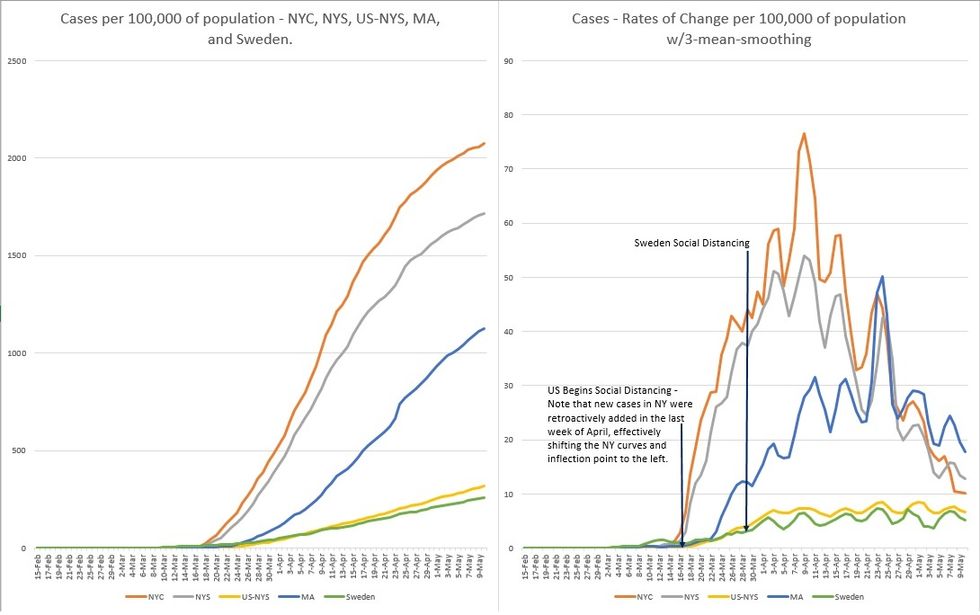By Anthony Lee, MD
Faculty, Harvard Medical School
As we make our way through this pandemic, the large number of cases in the United States has caught our attention and prompted much discussion. In Part 6 of this series, we continue to see Ireland and the UK consistently decline in number of daily deaths. If we assume that the pandemic in these countries is on the mend, tracking the number of cases is no longer fruitful.
Likewise, Italy, Belgium, and Northern Ireland have not seen increases in daily new cases, or deaths, over the last 3-6 weeks so we will no longer follow them. However, as these countries begin easing lockdown measures, this may change.
Please note that this report will only consider confirmed COVID deaths.
As explained in Part 4 and Part 5, it’s the case density (cases per 100,000 people) that matters and not the total number of cases. The higher the number of cases per 100,000 people, the more dangerous that location is. For example: riding in a subway car. If a specific location has a high case density, it’s more likely that riding on a subway car in that location will have more infected passengers compared to a subway car in a different location.

In Figure 1, Plots of New York City and New York State are compared to Massachusetts, “The Rest of the United States” (US minus NYS or US-NYS), and Sweden.
On the left of Figure 1, Massachusetts’ cumulative number of cases continues to rise. On the right of Figure 1, the number of daily new cases in Massachusetts is declining. However, its daily new cases now exceed that of NYS, which started to decline 15 days prior.
Want to READ MORE?
COVID-19 Part 5: Massachusetts Tops New York in Number of Daily New Cases Per Capita
COVID-19 – Part 3: The Inflection Point
This pattern is very similar to that of NYC, with a shift to the right of 15 days. Although NYS started social distancing measures concurrent with Massachusetts – which had far fewer cases per capita – Massachusetts continued to rise, peaking 15 days after NYS peaked.
But to maintain perspective, NYS still carries 25.4% of all cases in the US and 8% of all cases in the world, but this is decreasing. In contrast, Massachusetts carries 5.9% of all cases in the US and 1.9% of all cases in the world, but this is gradually increasing.
25 days after starting light social distancing measures and an increase in testing, Sweden’s number of daily new cases peaked on April 23. More significantly, Figure 2 (below) shows that Sweden’s peak in daily deaths occurred at about the same time and has been improving over the last 18 days. This is amazing considering that their mitigation efforts were very mild compared to those in the rest of Europe.

Figure 2 shows that in Ireland, the maximum daily deaths occurred on 4/25 – 29 days after lockdown and 14 days after their peak number of daily cases. In the UK, the maximum daily deaths occurred on 4/11 – 15 days after lockdown.
As the majority of cases and deaths in NYS occurred in NYC, it would be expected that peak numbers of daily new cases and daily deaths would occur around the same time. This happened on 4/9-10 – 22-23 days after social distancing began.
For “The Rest of the United States” (US minus NYS or US-NYS), the data (Total US) was updated last week. With that, the maximum number of daily new cases and deaths occurred on 4/29 – 42 days after the start of social distancing.
For Massachusetts, the peak number of daily new cases and daily deaths peaked on 4/24 – 37 days after social distancing, or 14-15 days after NYS.
Questions that come to mind are:
1. Why did it take Massachusetts 37 days to improve after the start of social distancing, despite beginning with only 218 cases and no deaths, while NYC took only 22 days to improve, beginning with 923 cases (4x Massachusetts) and 7 deaths?
2. How did Sweden improve its numbers in 25 days – with very late and quite mild social distancing – despite beginning with 3,700 cases and 110 deaths?
Sources of data: Worldometer.com, Spectrum News NY1, New York State Department of Health, Massachusetts Department of Public Health, HSC Public Health Agency





